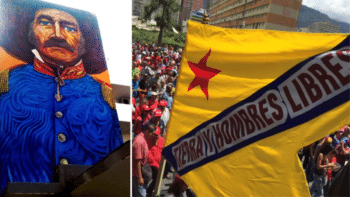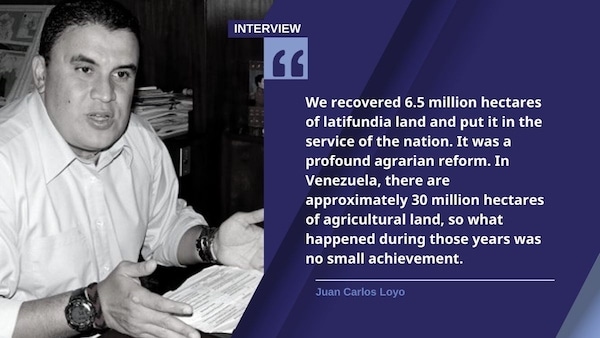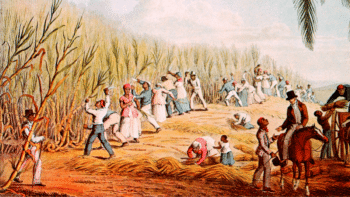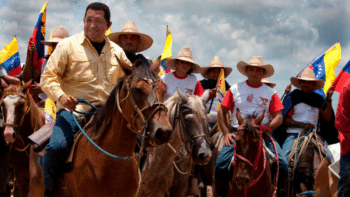Juan Carlos Loyo held various posts in Chávez’s Land Rep, including Minister of Agriculture from 2010 to 2013. Today Loyo is a researcher and a professor of political economy at the Bolivarian University in Caracas. In this two-part interview, he talks about the origin of Venezuela’s latifundia–large tracts of landed property, under a regime of low-intensity production–and the radical agrarian reform that Hugo Chávez tried to carry out during the heyday of the Bolivarian process.
In the debates about Venezuela’s ongoing struggle for the land, the origins of the latifundia are often left out. However, the latifundium was the defining form of landed property before the Bolivarian Revolution. What can you tell us about its history?
Let’s take the Spanish colonization as a starting point and the many rebellions and insurrections that followed the intitial process of dispossession.
When the Spanish occupied this territory, the crown handed over large tracts of land to what today we might call the agrarian bourgeoisie. People who had served the interests of the crown were retributed with land, which of course meant violently displacing the people inhabiting the territory. If we look at our history, we will discover that the latifundia structure implanted by the colonists survives up until the 21st century.
Of course, it’s worth mentioning that the Libertador [term used to refer to Simón Bolívar] promulgated the Law of Military Assets. The law altered the social order because it gave land to those who had participated in the Independence War. However, with Bolívar’s death, not only was the Law of Military Assets modified, but the lands that had been given by decree generally ended up going back to the old landowners.
The 19th century was characterized by many insurrections. The most critical moment was the Federal War [1847-1863] led by General Ezequiel Zamora, who bequeathed to us the war-cry: “Free land and free men!” Historian Néstor Tablante y Garrido documents no less than 44 rebellions between the years of 1830 and 1903. Tablante y Garrido calls those “the years of continuous violence.”
However, the logic of the latifundia continued into the 20th century. In fact, Juán Vicente Gómez [Venezuelan dictator from 1908-1935], who initiated the Venezuelan 20th century, was a large landowner. Nonetheless, with the beginning of oil extraction and the formation of the modern Venezuelan state in the 1920s, the conflict over agrarian land changed its nature. Still, at the time, the forms of land tenure remained unmodified. In fact, a 1937 census shows that of the approximately 69,000 landowners registered by the state, 3000 owned 90% of the land, 412 owned close to 8 million hectares, while only 13 owned more than two and a half million hectares.
The first attempt to deal with the land problem in the 20th century happened in 1961 with the Agrarian Reform Law of Rómulo Betancourt [Venezuelan president, 1945-1948 and 1959-1964]. However, at its core, the law fell short of an agrarian reform.
During his prior exile, Betancourt had witnessed the revolutionary potential of the struggle for land in Central and South America. That is why he promoted a carefully supervised or controlled land reform, which was carried out with the local elite on board. In fact, in the 1980s, even the Senate of the Republic determined that Betancourt’s attempted agrarian reform had failed.
Why was it a failure? Because it did not change the latifundia property structure. In the best of cases, campesinos were given small plots of not-so-desirable land that had previously belonged to the state, not to the large landowners.
Thus, when the Bolivarian Revolution arrived in 1998, land tenure in Venezuela was still defined by the old latifundia structures that had been overcome in many countries during the 20th century.
What are the main characteristics of Venezuelan latifundia?
The latifundia is a form of land ownership that is not just characterized by its large extension, but also by its low-yield production. For example, in Apure state [in southern Venezuela], landowners occupied land for non-intensive cattle raising, and it is very inefficient from a productive standpoint.
Moreover, this type of model displaces campesinos. If we were to look at a satellite photo of Apure, we would see that the campesinos have been corralled on the banks of the rivers, which are areas where crops are often lost when the water level rises in winter, or where agriculture is simply not viable.
In sum, the latifundia is an economic structure that is not only socially and economically unjust, but it is also of little or no use to the nation.
You mentioned that in Venezuela, throughout the 20th century, the only important land reform happened in 1961, but that it was very restricted and didn’t really change the organization of property in the countryside. Why is it that there wasn’t a more radical land reform here, as happened in most of the continent?
When Venezuela became an oil-producing country, the struggle for the land became a secondary issue. The main objective became capturing as large a chunk of the oil rent as possible.
Additionally, the economic reorganization of society brought about by oil exploitation triggered a huge exodus from the countryside to the city. Venezuela’s population became more and more urban and concentrated in the northern coastal center of the country, where state services also concentrated. We could say that this dynamic made the countryside invisible. The principal conflict became access to what the oil rent had to offer, from basic services to decadent wealth.
In the last decade of the 20th century, however, there were some interesting struggles for land that would leave their mark in the Bolivarian Process. Can you tell us about them?
Yes, in fact, there are two struggles that were important for the renewed left that was emerging in the 90s. The first one is Los Cañizos Paloquemao in Yaracuy, where campesinos occupied a large estate and received a lot of support from leftist university movements.
There is another very important episode: campesino communities in the center of the country confronted the Irish multinational Smurfit Kappa Group, which owned large tracts of land. The young social activist Antonia Muñoz and Douglas Bravo [60s guerrilla commander] participated in this struggle.
These struggles were carried out without any kind of protection from the state. In fact, the state repressed all campesino land struggles during the Fourth Republic [1958-1999].
It was roughly at the time of the Paloquemao and Smurfit struggles that Chávez was developing the idea of the “Tree of Three Roots.” In the mid-80s he spent some time deployed in Elorza, in the plains state of Apure, where he had been sent as punishment for his subversive activity within the armed forces.
There he learned about the injustices of latifundia: the inequality and poverty it generates. The Tree of Three Roots would become the ideological framework for the revolution, and it highlighted Simón Bolívar, Venezuela’s independence leader, and his teacher Simón Rodríguez, but it also included General Ezequiel Zamora, the popular leader of the war against the oligarchy and the latifundia in the 19th Century.
The 1999 Constitution was relatively progressive on issues related to land tenure. Could you outline the constitution’s key articles regarding land distribution in Venezuela?
The 1999 Constitution is a very rich document that incorporates the plurality of demands of the pueblo and the mass movement that had accompanied Chávez. It contains, in a condensed form, a proposal for reorganizing Venezuelan society that had been brewing for years.
When it comes to the problem of the land, the central issue expresses itself in the articles that state that latifundia run contrary to the interests of the nation. The constitution also obliges the state to go against this kind of landholding model.
Two years after the Constitutional Referendum, in 2001, Chávez promoted the Land Law, which was a turning point in Venezuela’s history. What did this law represent?
The Land Law established that the latifundia–which is that tract of land that exceeds the regional average–must be eradicated because it goes against the interests of the nation.
To recover latifundia land, two conditions must be met. First, you must demonstrate that the land is producing 50% below its potential. Second, whoever claims to be the owner must not be able to produce proof of the private origin of the land. In Venezuela, since independence, all property has had a state-produced title.
That is why the person who claims to be the owner must be able to prove the origin of the property. This happens not only in Venezuela, but all around the world: if I want to sell a car, I must prove its origin.
The Land Law also recognises campesino land occupations. In such situations, there are mechanisms that give the campesinos the right to remain on the land. If you occupy formerly idle land for more than two years, and you are producing, then you have the right to a title that allows you to continue occupying and working the land. You are not the owner, but you have the right to usufruct the land.
The Land Law seeks to protect the weakest people in the agrarian structure: the campesino family and women in particular. That is why the law favors giving titles not to the “head of the family” but to whole families or to collectives.
Additionally, the Land Law bound the state to provide campesinos with the tools and equipment needed for farming. For a few years, implements, seeds, and even tractors were given to campesinos. The law bound the state to do so. All this was the outcome of a long struggle, and because of Chávez’s commitment to justice and raising production levels. It was made possible because the nation had gained control of its main resource: oil.
The Land Law unleashed the bourgeoisie’s fury. There was an episode in which the President of FEDENAGA [national association of large cattle ranchers] Jose Luis Betancourt publicly tore up the law in contempt as a symbolic gesture.
The 2001 Land Law and other groundbreaking legislation that was passed triggered the 2002 coup d’état. This is not surprising: the Land Law touched the interests of some of the most powerful sectors of the bourgeoisie.
What was the actual impact of the Land Law?
The first stage of land reform took place between 2003 and 2005. During that period, the state resolved some longstanding campesino conflicts–above all, in Cojedes, Apure, and Yaracuy.
At that time the Fundos Zamoranos–which were campesino initiatives involving cooperative farming–began to emerge. Endogenous development nuclei [collectivized initiatives that received direct state financing] also emerged around the same time.
In Venezuela, 70% of the population lives in 30% of the territory. So at that time, the government was also trying to favor a return to the countryside with a view to fostering agricultural production.

A mural of General Ezequiel Zamora and the “Zamorana” flag, which reads “Land and free men.” (Tatuy TV)
During the early days of the Bolivarian Revolution, the government also carried out a census of the countryside and made a map of all the existing latifundia.
That was the first stage of the agrarian revolution under Chávez. What happened after 2005?
The second stage, which went through 2009-2010, is when the Venezuelan state took on a truly active role in the struggle against latifundia. By then, with the help of the agricultural census, the ongoing problem of the latifundia became very evident. The results were striking: out of 2445 existing estates, less than 1% occupied 7 million hectares, which is almost 25% of the agrarian land in the country.
The Land Law’s struggle against large estates really began with force in 2005. In those years, we intervened huge ranches such as La Marqueseña and La Vergareña. These actions were symbolically important.
The interventions in latifundia were the most visible agrarian policy during that five-year period. However, during that time, historical conflicts continued to be resolved in favor of the campesinos, and campesinos likewise received direct support from the government.
What happened after 2009-2010. Was there a new agrarian strategy?
More than a new strategy, I would say that after 2010, the focus became the nation’s recovery of type I and type II soils, which are highly productive but less common. The objective was to make good on the Simón Bolívar National Plan, which stated that the state should foster agrarian production.
Those were the years in which the struggles in the Aragua-Carabobo Valley and Sur del Lago took place. The occupations of land in the Sur del Lago were very visible because there were people in that land who had lived in conditions of semi-slavery. There, in the Turbio River Valley [Lara and Portuguesa states] and in other places, we encountered complex situations, marked by social exclusion. Although those were the best lands in the country, their production had stalled long ago. Meanwhile, people living in huts on the edge of the latifundia had been plunged into poverty and had no access to the land.
In a few words, the strategic objective from 2010 until Chávez’s death was to intervene in the land and reactivate agriculture for the nation’s development.
How much land was recovered between 2003 and 2012?
We recovered 6.5 million hectares of latifundia land and put it in the service of the nation. That is why we can say there was a profound agrarian reform. In Venezuela, there are approximately 30 million hectares of agricultural land, so what happened during those years was no small achievement.




